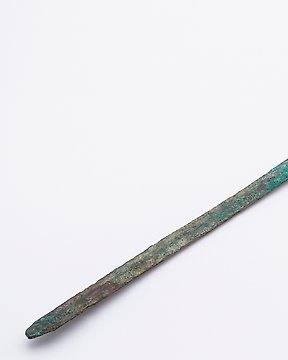
Luristan Bronze Rare poignard étroit à garde partielle en os. Licence d'exportation espagnole. - 30.5 cm
Nº 81962789

Nº 81962789

Aesthetic bronze narrow full tang dagger with a very simple and unusually sober design that has little to no ornamentation along the blade, or its partially preserved bone hilt with only two symmetrical crescent moon shaped dips along the base of the hilt and a hole that as far as I can reason could have been use for carrying the dagger with a threaded string or as the place of attachment for a fabric ornamentation.
This specimen as far as the record goes came from a private Japanese collection in which it stayed from 1970 to 2010, when it was sold I am guessing as part of a bigger lot to Ancient&Oriental a London based dealer who held it till 2022 when it was finally sold to us.
Lorestan Bronzes proper come from funerary burring sites in the Lorestan region that encompasses modern western Persia's lorestan and Kermanshah provinces, this being most likely produced by semi transhumantic tribes, of indeterminate ethnicity during the regional lower to upper Iron Age (1000BCE to 650 BCE). In this case tho, the style and production of the piece does not quite fit the standard for pieces from this time frame, which are typically casted in one piece and adorned in a very particular way with soft curved lines and complex zoomorphic, anthropomorphic and or botanical motifs. Nor fits with the very early and extremely rare metal artifacts from this region's lower bronze (~3000BCE-~2000BCE) that are clearly distinguished by a more Mesopotamian, utilitarian and simpler stile and in the case of daggers knifes and swords are forged rather than casted and are not usually full tanged. As such, this dagger was probably created in the time bracket that includes the transitional stage between the two periods and the Lorestan bronzes proper stage(2000BCE-650BCE).
Also of note is the fact that unlike other daggers from the same region and period which tended to have broad profiles This dagger probably is one of the thinnest and longest I have seen even after comparing with hundreds of pieces featured in catalogs and publications and as such it was probably used for ceremonial purposes either burying rites or religious worship as I doubt anyone could use it without bending or breaking the blade.
The dagger is pretty decently preserved not holding an edge, but still everything is there and it is structurally sound and also as far as can be seen, no restorations are present anywhere in the piece.
Comes with a certificate of autheticity from the original dealer and it has been assessed as authentic by an independent private dealer and an auction house. If necesary more information may be requested by any interested buyers and in case you are bidding from a non EU country be warned that this item will take at maximum a month to get mailed to you due to the need for personalized export licenses.
Comment acheter sur Catawiki ?
1. Découvrez des objets d’exception
2. Faites la meilleure offre
3. Effectuez un paiement sécurisé